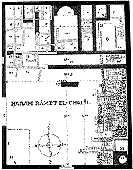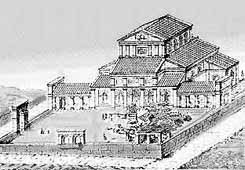Constantine reconvens the Council of Nicaea (at Nicomedia).
The Imperial quarters at Trier demolished; then Trier's cathedral was built on the remains.
| |
It is uncertain whether the origins of the Helena-tradition date back as far as the first quarter of the fourth century. If it does, we can wonder whether this tradition goes back to the elder Helena. It seems reasonable to assume that the frescoes were made for the occasion of the wedding of Crispus and [the younger] Helena. The attributes on the frescoes refer to married life, as do the putti. The marriage took place c.321. Hardly anything is known about the younger Helena, except that she was married to Crispus, bore him a child in 322 and was probably with child in 324. The man with the scroll may also be connected with Crispus (and [the younger] Helena); he is identified as Lactantius, Crispus' teacher. A suitable place for paintings referring to the happiness of married life is naturally the bedroom, the cubile. It therefore seems plausible to consider the frescoed room not as the cubile of the elder Helena, as Kempf suggests, but as that of the younger Helena. This bedroom was part of the great complex of imperial quarters in which the Caesar Crispus and his wife Helena lived. In 326, after Crispus' execution and damnatio memoriae, the quarters, including the cubile, were demolished; then Trier's cathedral was built on the remains. Although very little is known about the younger Helena, it is not impossible that her cubile and domus were known among the inhabitants of Trier as the cubile and domus of Helena, as we find in the medieval texts. The younger Helena soon disappeared into oblivion, and the cubile and domus were soon considered to have been those of the much more famous elder Helena. The latter was a renowned and indeed legendary figure because of her alleged discovery of Christ's Cross. Moreover, her name was often mentioned in connection with the foundation of churches. Both Helenas may possibly have become confused, which might explain why in the Middle Ages the origin of the Helena-tradition at Trier is dated back to the elder Helena. It may in fact have been the figure of the younger Helena which lay at its roots. For this reason various medieval vitae may attribute Helena's descent to an illustrious family in Trier. Perhaps the younger Helena, about whose origin nothing is mentioned in the sources, came from a rich and distinguished family in Trier? Maybe Crispus, who resided in Trier from 316 onwards, had met her in this northern capital. Her relatively ignoble descent -- the local aristocracy of Trier -- and hence her obscurity, could clarify why, even while Crispus was still alive, the younger Helena is not mentioned in the ancient historiography of the Constantinian period.
Jan Willem Drijvers, Helena Augusta: the mother of Constantine the Great and the legend of her finding the true cross (New York: E.J. Brill, 1992), p. 28-29.
Trier's cathedral, dedicated to St Peter, has a long history which ultimately reaches back to the time of Constantine. Our mediaeval sources report that Helena donated her "house" in Trier, so that it might become a church, and that Bishop Agritius of Trier dedicated this church. The mediaeval sources which offer this statement are generally not very reliable, and it is known that the cathedral was not completed until many years after Helena had left Trier and also some years after Bishop Agritius had died. It is not surprising, therefore, that in the past scholars have denied that Helena had anything to do with the beginnings of Trier's cathedral. But archaeological excavations underneath the nave of the cathedral in 1945-6 and again in 1965-8 have dramatically changed that view. These excavations revealed a room, measuring c. 10 x 7 m, which had been built after 316, but was torn down after 330. The location, the date of construction and the quality of the decorations have persuaded investigators that this room was once part of the imperial residence, "Helena's house," and that it was taken down to make room for the Constantinian church. The painted ceiling of the room was found in situ but in thousands of fragments. The fifteen panels which made up this ceiling have been painstakingly restored and are exhibited in Trier's diocesan museum. Four of these fifteen panels depict richly dressed and bejewelled ladies, who represent either members of the imperial family or allegorical figures. If the former interpretation be right, the four ladies would be Constantine's mother Helena, his wife Fausta, his half-sister Constantia, and the wife of his son Crispus, also named Helena. This writer is persuaded that the latter interpretation is the correct one.
Hans A. Pohlsander, The Emperor Constantine (New York: Routledge, 1996), pp. 17-18.
| |
 
Plan and reconstruction of the sacred enclosure of Mamre in Constantinian times (after Mader, 1957).
The site of Mamre. known in Arabic as Haram Ramet el-Khalil, lies approximately 3 kin (2 mi.) north of Hebron (map reference 1088.1602). on the ancient road linking the main Hebron-Jerusalem and Bcthlehem-Ziph routes. The Bible describes Elonei (oaks of) Mamre as Abraham's dwelling place, Ahere lie built an altar to God (Gen. 13:18, 18:1. 23:19). Sonic scholars locate the biblical Elonei Mamre within the town of ancient Hebron (Tell Rumeideh); others identify, it with the enclosure of Haram Ramet el-Khalil. which was already considered a sacred site in the Second Temple period.
Josephus relates that Abraham resided near Hebron, by an oak called ogyges, the oak of genesis (Antiq. 1, 186). Elsewhere he mentions a terebinth 6 stadia from Hebron that had stood there since creation ( War IV, 533); it is not clear whether both references are to the same place. In Antiquities he tells the biblical story, calling the tree Lin oak: whereas in War of the Jews he is describing a holy place in his own time. calling it a terebinth. Josephus is mistaken about the distance between Elonei Mamre Lind Hebron, which is not 6 but approximately 18 stadia (3 km). Neither does he mention a structure around the terebinth. Modern excavations have made it clear that the structure was already standing in his time.
The book of Jubilees (29:17-19; 37:14. 17) refers to Abraham's capital in the Hebron Hills as a tower (migdal). The reference is probably to Abraham's residence Lit Elonei Mamre. If so, the author, a contemporary of the Second Temple, was describing the enclosure at Elonei Mamre in terms associated with the Temple Mount--migdal or birah--both meaning tower or fortress. Talmudic literature refers to the place as Beth Ilanim or Botnah. and it is mentioned as the site of one of the most important fairs in Palestine: "There are three fairs: the fair of Gaza, the fair of Acco, the fair of Botnah, and the least doubtful of them all is the fair of Botnah," meaning that of the three fairs this was the one most definitely associated with idolatry and therefore Jews were forbidden to participate in it (J.T., A.Z. 39c; Gen. Rab. 47: 10). The fair is mentioned in two of Jerome's commentaries (In Hieremiam VI, 18, 6, CCSL 74, 307; In Zachariam 111, 11, 4-5. CCSL 76A, 851), where it is said that Hadrian brought the captive Jews to the famous marketplace at Terebinth. There he sold many into slavery. For this reason the Jews in Jerome's time shunned the annual fair. The same story is told in the seventh-century Chronicon Paschale (PG 92, col. 613) with some additions.
The Bordeaux Pilgrim (Itin. Burd. 599, 3-7) states that the emperor Constantine built a basilica there. Eusebius (Vita Constantini III. 51-53, GCS 7, 99-10 1) and Sozomenus (HE II, 4. GCS 50, 54-56) report the circumstances and the official documentation referring to the building. Both Julius Africanus (Chron. XVIII) and Eusebius (Vita Constantini III, 53, 100; Onom. 6. 12-14; 76. 1-3) mention a pagan altar at the site.
The most detailed description of the site is in the work of Sozomenos (op. cit.). He reports that the place. situated 15 stadia from Hebron, was the site of the terebinth, where the angels had appeared to Abraham. In summer, he states. a great fair was held there. attracting hordes of people from far away. who came to offer libations and burn incense, but also to trade; among them were pagans, Christians and Jews.
The Medeba map seems to differentiate between Botna and Mamre, as the mosaic depicts both a church and a terebinth. During the seventh century CE there was a monastery at the site that continued to exist after the Arab conquest (Adamnanus, De Locis Sanctis II, II. 6, CCSL 175, 211). In Crusader times, the site may have been occupied by the Church of the Trinity.
Itzhaq Magen, The New Encyclopedia of Archaelogical Excavations in the Holy Land, Jerusalem 1993, ad v. "Mamre" (extract).
|

